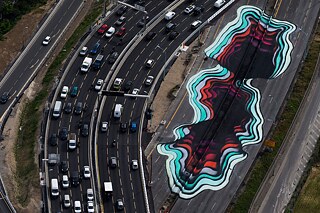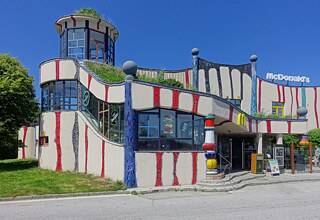Saskia Trebing Art on the motorway

What’s the difference between a museum and a motorway? The exhibition visitors zoom past your art within a second. So the artist needs to come up with something pretty special. Saskia Trebing has scoured embankments, motorway services and carriageway surfaces on the look-out for motorway art, and she presents her remarkable selection here for your enjoyment.
Black-and-white, full of geometric figures and formally incorruptible: maybe the motorway itself is the greatest artwork of all. The bright, clear lines on white tarmac are abstract painting perfection. The masses of earth that had to be moved and shaped to build the carriageway sections would turn any land artist green with envy. Flying along at 130 km/h (or in Germany even sometimes twice that) dissolves the world outside the car window into multi-coloured streaks. And the hours of driving in a straight line through terrain that’s generally only of moderate interest bears hallmarks of an endurance feat. So it isn’t any wonder that virtually no other element of the transport infrastructure is so frequently painted, photographed, written about and sung about: from Kraftwerk’s Autobahn to Highway To Hell by AC/DC.But even on the highways themselves – if you don’t disappear completely into your tunnel vision as a driver – there is always new art to discover. Sometimes a local authority has been persuaded to let graffiti artists decorate the roadside acoustic barriers. Sometimes the billboards, intended as an advertising medium for all sorts of products in the USA and increasingly in Europe as well, are used as oversized art canvases. Such a huge viewing public as you get on a multi-lane arterial road cannot be found at any other exhibition gallery in the world. Mind you, how many people look at it properly is another question. And after a few seconds they have whizzed past this public exhibition again.
Arc Majeur, or the Giant Arc, in Belgium
Travellers encounter a big name in art history (whether they want to or not) on the E411 near the Belgian castle of Lavaux-Sainte-Anne in Wallonia. That’s where sculptor Bernar Venet, who is famous for his supersize structures, installed his Arc Majeur in 2019. This work is an arc made of 250 tonnes of Corten steel 60 metres high, which appears to sink into the earth on one side of the road and emerge again on the other. Its message is somewhat unclear – is it meant to frame that section of road, suggest a sort of inverse tunnel, or represent the consequences of a gigantic accident involving mangled metalwork? However, Venet’s creation is without a doubt one of the largest sculptures in Europe. The cars and lorries driving past look like toy vehicles alongside the curvaceous monster. At night this minimal art in maximum format is illuminated by headlights. And thereby serves as a sort of modern-day lighthouse on land.

Cubes and cylinders in France
The art on the French Autoroute A4 near the city of Reims, whilst not quite so spectacular is still conceptually ingenious. It’s a series of colourful geometric shapes unfurling on the embankments along a 25-kilometre stretch of road: cubes, rectangular slabs, painted cylinders and triangles, or globelike spheres. The collection is a work by artist Guy de Rougemont, who arranged the objects there in 1974. As well as an introduction to the theory of form and colour, the extensive work is also intended to incorporate a safety aspect: because this length of carriageway is particularly monotonous and uneventful, the bright eyecatchers are designed to catch the attention of drivers and thereby prevent them from falling asleep at the wheel. The fact that the art cares so touchingly about the welfare of its public is truly no coincidence.

A colourful hole in Paris
Generally speaking, France’s transport network appears to be a fertile ground for art at street level. In 2015 the Hamburg duo TenTen 1010 painted a disused piece of the Paris urban expressway Périphérique with powerful swathes of colour. Drivers on the new road next to it could only see a few coloured shapes, it was only when viewed from above that the entire form of the artwork was revealed. From a birds-eye perspective the painting resolves into an enormous hole in the carriageway – effective but luckily not at all hazardous.

Filling station architecture in Austria
If you do need a break after driving for hours, you can also find art at some of the motorway services, even if its tastefulness is sometimes a little questionable. The most famous take on filling station architecture can be found on the A2, in Bad Fischau/Austria. The service area there was designed on the basis of plans by artist Friedensreich Hundertwasser and is distinguished by its characteristic rainbow towers and a roof terrace. Any car driver who feels like a king of the road can rest that weary accelerator foot here, in a dreamy little fantasy castle. In an infrastructure where most service stations are as uniformly designed as the traffic bollards at the side of the road, creative mavericks like this add variety that travellers appreciate seeing.
